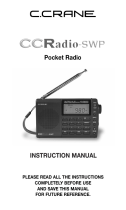Eton Weather Radio G4000A User manual
- Category
- Radios
- Type
- User manual
This manual is also suitable for
Eton Weather Radio G4000A is a portable radio that can receive AM, FM, and shortwave broadcasts. It also has a built-in weather band receiver, which can be used to listen to weather forecasts and alerts. The radio is powered by six AA batteries or an AC adapter, and it has a built-in speaker and a headphone jack.
Eton Weather Radio G4000A is a portable radio that can receive AM, FM, and shortwave broadcasts. It also has a built-in weather band receiver, which can be used to listen to weather forecasts and alerts. The radio is powered by six AA batteries or an AC adapter, and it has a built-in speaker and a headphone jack.



















-
 1
1
-
 2
2
-
 3
3
-
 4
4
-
 5
5
-
 6
6
-
 7
7
-
 8
8
-
 9
9
-
 10
10
-
 11
11
-
 12
12
-
 13
13
-
 14
14
-
 15
15
-
 16
16
-
 17
17
-
 18
18
-
 19
19
Eton Weather Radio G4000A User manual
- Category
- Radios
- Type
- User manual
- This manual is also suitable for
Eton Weather Radio G4000A is a portable radio that can receive AM, FM, and shortwave broadcasts. It also has a built-in weather band receiver, which can be used to listen to weather forecasts and alerts. The radio is powered by six AA batteries or an AC adapter, and it has a built-in speaker and a headphone jack.
Ask a question and I''ll find the answer in the document
Finding information in a document is now easier with AI
Related papers
Other documents
-
Grundig Yacht Boy 400 PE User manual
-
Grundig YACHT BOY 400 Owner's manual
-
Sony ICF-SW7600GR User manual
-
Sony 3-227-586-15 User manual
-
Grundig TOUGH ENOUGH GS350DL User manual
-
Sony ICF-SW7600GR Owner's manual
-
 Kaito KA009R User manual
Kaito KA009R User manual
-
Grundig G5 GLOBE TRAVELER Owner's manual
-
Realistic DX-440 User manual
-
 C. Crane 024 S User manual
C. Crane 024 S User manual




















